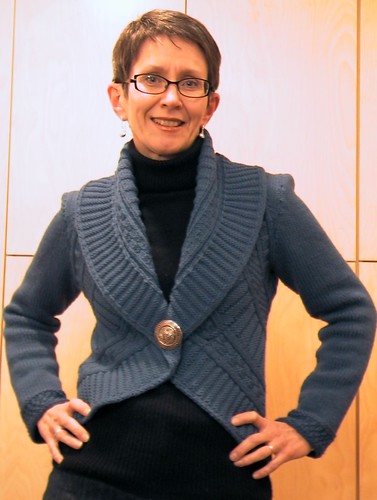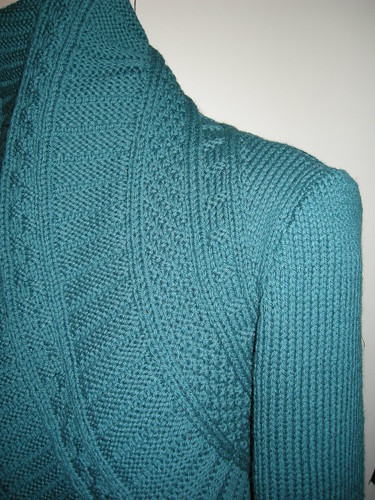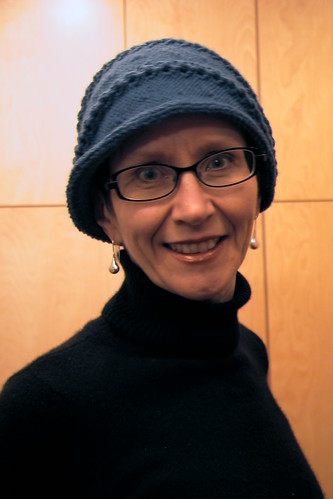While the Teal Jakku pieces were blocking I seem to have knit a hat out of my leftover wool. Please excuse my slightly stunned expression. I think it's caused by the unexpectedly speedy pace of my production.
This is the Tundra Toque, designed by Carolyn Doe (available on Ravelry). I love the asymmetrical shape. I'm not completely fond of inside-out stockinette stitch, and the fact that you can see the increases and decreases between the lacy cables on the brim. And I think the crown of the hat is too pointy. (I am trying to block it out.)

Here's another shot that shows the shape of the brim better. There are 5 cables that join in the centre of the crown. It goes pretty well with the resurrected Burda 7731 coat.

The other piece, of course, is the Teal Jakku. It took about 3 days for the pieces to dry, and another 3 to sew the thing together and weave in all the ends. (Am I supposed to sew it together and then block, or block before sewing? Experienced knitters, please advise.)
It has no closure. I've got this big silver pin that seems OK with it.
Thanks to the clearly explained knitting videos on KnittingHelp.com (also available as a $5 app for iPad - excellent value), the assembly of this project involved my first ever attempt at the Kitchener stitch, which is supposed to be completely invisible but in this case is merely not glaringly obvious. It was moderately difficult because I was seaming the deeply textured lower edge/collar, so there is a bit of disruption in the pattern. If you must know, it's mostly located under my left arm, but because of the angle of the pattern it isn't completely hidden by my arm. This location was suggested on Ravelry but in retrospect, I think the seam would have been less jarring if I'd placed it at the CB.
KnittingHelp also supplied a great explanation of the mattress stitch which I used to sew all the other pieces together pretty much invisibly.
For those of you who think I've gone over to the dark side and are wondering when The Sewing Lawyer is going to resume producing more interesting projects, here are a few sewing-related thoughts on knitting design and construction.
 According to some things I've read on the internet, some knitters will go to great lengths to avoid having to actually sew their knitted garments together. They'll knit a piece entirely in the round from the bottom up or the top down, splitting off at the shoulders to form separate in-the-round tubes for the sleeves, including increases and decreases to build in shaping (where you'd sew darts), and cleverly finding ways to include hems, pockets, buttonholes, collars and all manner of details which are joined by picking up stitches and knitting new details directly onto a completed piece. For example, the cloche hat brim is seamed at its narrowest point, but the crown is then knitted round and round, decreasing from 100 stitches picked up from one edge of the assembled brim. It's a new world.
According to some things I've read on the internet, some knitters will go to great lengths to avoid having to actually sew their knitted garments together. They'll knit a piece entirely in the round from the bottom up or the top down, splitting off at the shoulders to form separate in-the-round tubes for the sleeves, including increases and decreases to build in shaping (where you'd sew darts), and cleverly finding ways to include hems, pockets, buttonholes, collars and all manner of details which are joined by picking up stitches and knitting new details directly onto a completed piece. For example, the cloche hat brim is seamed at its narrowest point, but the crown is then knitted round and round, decreasing from 100 stitches picked up from one edge of the assembled brim. It's a new world. Sewing a knitted thing together with the same wool it's made from, and carefully picking up a row or stitch at a time at each edge of a seam means that even if the thing isn't knitted together, it looks like it was. The perfectionist in me really likes this fact.
As Sherry pointed out in a comment to my last post, the fact that knitted pieces stretch means they can be forced to go together, but this isn't necessarily a good thing. Understanding how flat shapes best fit the 3 dimensional human body without distortion (i.e. how sewing patterns work) seems immensely useful to me in knitting. My decision that I should insert a little triangle at the front shoulder area, instead of forcing a smoothly curved piece to fill in a right angle corner was definitely the right one.
I have a pair of badly needed black pants cut out; they'll look smashing with the jakku.

No comments:
Post a Comment